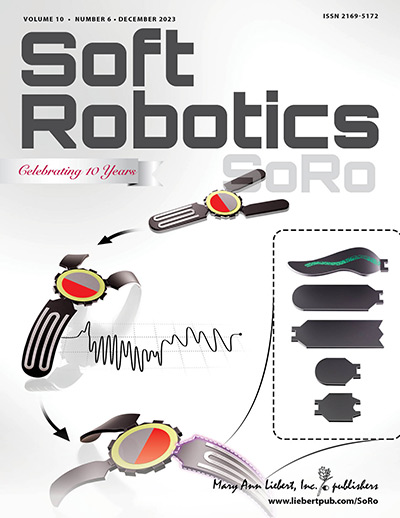Simultaneous Locomotion with Stiffness Perception of an Earthworm-Like Robot in a Soft Tubular Environment.
IF 6.1
2区 计算机科学
Q1 ROBOTICS
引用次数: 0
Abstract
Robots are frequently employed for navigation and detection tasks within tubular environments. However, when operating in soft tubular environments, they face significant challenges. The inherent instability of these structures can impede a robot's locomotion, and their soft tissues might be damaged by the interaction with robots. This study proposes a real-time stiffness perception system in soft tubular environments (e.g., colonic lumen) based on the earthworm-like movement to realize locomotion and detection simultaneously. The proposed soft robot features a central actuator (CA) for axial elongation and contraction, along with two auxiliary anchoring actuators positioned at the front and rear ends (FAA and RAA) to prevent backward slippage during locomotion. Notably, FAA is equipped with a perception mechanism capable of detecting the stiffness of the tubular environment through its interaction during inflation. The analytical modeling for CA's axial elongation, as well as the interaction between FAA and the surrounding tubular environment, has been developed and validated through experimental studies. Furthermore, the overall evaluation is conducted in two distinct tubes with: (1) uniform wall thickness but varied elastic moduli and (2) uniform elastic modulus but varied wall thicknesses. The successful locomotion and accurate perception confirm the capability and efficiency of the robot. In conclusion, the proposed robot system exhibits promising applications for locomotion and simultaneous stiffness detection in medical diagnostics and other fields where simultaneous locomotion and stiffness detection are crucial.软管环境中具有刚度感知的类蚯蚓机器人同步运动。
机器人经常用于管道环境中的导航和检测任务。然而,当在软管柱环境中作业时,它们面临着巨大的挑战。这些结构固有的不稳定性会阻碍机器人的运动,并且它们的软组织可能会因与机器人的相互作用而受损。本研究提出了一种基于类蚯蚓运动的软管环境(如结肠腔)实时刚度感知系统,实现运动与检测同时进行。所提出的软机器人具有用于轴向伸长和收缩的中央致动器(CA),以及位于前后端(FAA和RAA)的两个辅助锚定致动器,以防止运动期间向后滑动。值得注意的是,FAA配备了一个感知机制,能够通过膨胀过程中管柱环境的相互作用来检测管柱环境的刚度。建立了CA轴向伸长率的分析模型,以及FAA与周围管状环境的相互作用,并通过实验研究进行了验证。此外,在两个不同的管中进行了总体评价:(1)壁厚均匀但弹性模量不同,(2)壁厚均匀但弹性模量不同。成功的运动和准确的感知验证了机器人的能力和效率。总之,所提出的机器人系统在医学诊断和其他同时运动和刚度检测至关重要的领域显示出有前景的运动和同步刚度检测应用。
本文章由计算机程序翻译,如有差异,请以英文原文为准。
求助全文
约1分钟内获得全文
求助全文
来源期刊

Soft Robotics
ROBOTICS-
CiteScore
15.50
自引率
5.10%
发文量
128
期刊介绍:
Soft Robotics (SoRo) stands as a premier robotics journal, showcasing top-tier, peer-reviewed research on the forefront of soft and deformable robotics. Encompassing flexible electronics, materials science, computer science, and biomechanics, it pioneers breakthroughs in robotic technology capable of safe interaction with living systems and navigating complex environments, natural or human-made.
With a multidisciplinary approach, SoRo integrates advancements in biomedical engineering, biomechanics, mathematical modeling, biopolymer chemistry, computer science, and tissue engineering, offering comprehensive insights into constructing adaptable devices that can undergo significant changes in shape and size. This transformative technology finds critical applications in surgery, assistive healthcare devices, emergency search and rescue, space instrument repair, mine detection, and beyond.
 求助内容:
求助内容: 应助结果提醒方式:
应助结果提醒方式:


